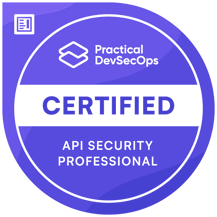From £750+ VAT
Book online today or, if you need help choosing the right course or would like to discuss business discounts, call us on 0113 220 7150.
Overview
This self-paced Certified API Security Professional e-learning course equips developers, architects, and security professionals with the comprehensive skills required to protect modern API ecosystems across REST, GraphQL, and SOAP. Covering the OWASP API Top 10, authentication, authorisation, input validation, rate limiting, DevSecOps integration, and real-time mitigation strategies, this certification prepares learners to detect and prevent the most critical API vulnerabilities. With more than 60 guided labs and real-world simulations using tools like Burp Suite, cURL, Postman, and HashiCorp Vault, this course delivers practical expertise aligned to enterprise and DevOps workflows.
Prerequisites
Participants should have:
- A basic understanding of Linux command line usage
- Familiarity with the OWASP Top 10 vulnerabilities
- Basic application development knowledge is helpful but not mandatory
Target audience
This course is ideal for:
- Application developers integrating APIs into web or mobile apps
- DevOps engineers and security professionals managing API endpoints
- Security architects designing scalable and secure API gateways
- Compliance and risk teams assessing API-related attack vectors
Objectives
By the end of this course, learners will be able to:
- Detect and prevent OWASP API Top 10 threats across REST, GraphQL, and SOAP
- Implement robust authentication strategies using OAuth, JWT, and mTLS
- Enforce advanced authorisation frameworks including RBAC, ABAC, and ReBAC
- Secure data using input validation, encryption, CSP, and secure headers
- Integrate SAST, DAST, and SCA tools into CI/CD workflows
- Deploy and manage secrets securely using tools like HashiCorp Vault
- Monitor APIs and automate security across deployment pipelines
Outline
Introduction to API security
- Overview of API architecture and HTTP protocols
- API protocols, data formats, and deployment models
- Stateless vs stateful API behaviours
- API threat modelling and common attack vectors
- API vs traditional web application testing
- Hands-on: HTTP servers, lab setup, and CI/CD demonstration
Tools of the API security trade
- Role of API gateways, proxies, and message queues
- Essential tools: cURL, Postman, OpenAPI, Burp Suite
- Reconnaissance and enumeration using FFUF and Swagger
- Hands-on: CRUD operations, API exploration, traffic interception
Authentication attacks and defences
- Common methods: Basic Auth, API keys, JWT, OAuth, OIDC, mTLS
- Brute force, insecure reset flows, token storage vulnerabilities
- Defence mechanisms: strong validation, MFA, CAPTCHA, rate limiting
- Hands-on: exploiting and hardening JWTs, password hash cracking
Authorisation attacks and defences
- Access models: RBAC, ABAC, DAC, ReBAC
- Vertical and horizontal privilege escalation
- OAuth 2.0 vs 2.1 and insecure OAuth configurations
- Hands-on: BOLA attacks, JWT privilege escalation
Input validation threats and defences
- Injection attacks: SQLi, XSS, SSRF, NoSQLi, deserialisation
- Validation vs sanitisation, regular expressions, output encoding
- Fuzzing and dynamic API abuse prevention
- Hands-on: mass assignment, SQLMAP, DOM XSS, GraphQL exploits
OWASP API Top 10 and additional threats
- Analysis of common vulnerabilities: BOLA, EDE, misconfigurations
- API abuse through CORS, caching, proxy and GraphQL/SOAP misuse
- Post-exploitation risks and API inventory mismanagement
- Hands-on: CORS abuse, XSS with elevated privileges
Advanced API defences
- Securing REST, GraphQL, and SOAP endpoints
- Data protection: encryption, hashing, escaping
- Secure headers: CSP, HSTS, X-Frame-Options
- Hands-on: Kong Gateway rate limiting, CSP implementation
Implementing API security mechanisms
- Designing secure OAuth scopes and permissions
- Reverse proxy and load balancer configurations
- Logging with ELK stack and syslog formats
- Secrets management using HashiCorp Vault
- Hands-on: secure secrets storage, Docker monitoring with Grafana
API security in DevSecOps
- Applying the OWASP ASVS framework
- Automating SCA, SAST, and DAST in CI/CD pipelines
- Mitigating risks at scale through policy enforcement
- Hands-on: DevSecOps pipeline with API deployment and automated scanning
Exams and assessments
Participants must complete a certification exam to earn the Certified API Security Professional™ credential. The course includes:
- One exam attempt included
- Realistic scenario-based exercises across key attack and defence topics
- Continuous knowledge checks to validate learning outcomes
- The exam is a task-oriented examination in which you will be required to solve 5 challenges within a timeframe of 6 hours, with an additional 24 hours to complete the report and submit it for evaluation.
Hands-on learning
This course with approx. 20hrs of e-learning includes:
- Over 60 interactive labs replicating real-world attack scenarios
- Guided exercises with Burp Suite, cURL, Postman, and HashiCorp Vault
- Vulnerability discovery through SAST, DAST, and SCA integrations
- Continuous deployment pipelines for secure microservices
- Monitoring and defence automation in production environments
- Upon completion of the purchase, learners will have the opportunity to select their preferred commencement date. The course will be provided on the chosen start date.
- 3-years of access to the videos and checklists, 60 days of browser-based labs, PDF Manual.
What's included
- Exam included
- Online exam voucher
- Dedicated tutor support via email during your course from expert instructors
Practical DevSecOps Certified API Security Professional

Cyber Security learning paths
Want to boost your career in cyber security? Click on the roles below to see QA's learning pathways, specially designed to give you the skills to succeed.
Software learning paths
Want to boost your career in software engineering? Click on the roles below to see QA's learning pathways, specially designed to give you the skills to succeed.
Secure Engineering learning paths
Want to boost your career in Secure Engineering? View QA's learning pathway below, specially designed to give you the skills to succeed.

Frequently asked questions
How can I create an account on myQA.com?
There are a number of ways to create an account. If you are a self-funder, simply select the "Create account" option on the login page.
If you have been booked onto a course by your company, you will receive a confirmation email. From this email, select "Sign into myQA" and you will be taken to the "Create account" page. Complete all of the details and select "Create account".
If you have the booking number you can also go here and select the "I have a booking number" option. Enter the booking reference and your surname. If the details match, you will be taken to the "Create account" page from where you can enter your details and confirm your account.
Find more answers to frequently asked questions in our FAQs: Bookings & Cancellations page.
How do QA’s virtual classroom courses work?
Our virtual classroom courses allow you to access award-winning classroom training, without leaving your home or office. Our learning professionals are specially trained on how to interact with remote attendees and our remote labs ensure all participants can take part in hands-on exercises wherever they are.
We use the WebEx video conferencing platform by Cisco. Before you book, check that you meet the WebEx system requirements and run a test meeting to ensure the software is compatible with your firewall settings. If it doesn’t work, try adjusting your settings or contact your IT department about permitting the website.
How do QA’s online courses work?
QA online courses, also commonly known as distance learning courses or elearning courses, take the form of interactive software designed for individual learning, but you will also have access to full support from our subject-matter experts for the duration of your course. When you book a QA online learning course you will receive immediate access to it through our e-learning platform and you can start to learn straight away, from any compatible device. Access to the online learning platform is valid for one year from the booking date.
All courses are built around case studies and presented in an engaging format, which includes storytelling elements, video, audio and humour. Every case study is supported by sample documents and a collection of Knowledge Nuggets that provide more in-depth detail on the wider processes.
When will I receive my joining instructions?
Joining instructions for QA courses are sent two weeks prior to the course start date, or immediately if the booking is confirmed within this timeframe. For course bookings made via QA but delivered by a third-party supplier, joining instructions are sent to attendees prior to the training course, but timescales vary depending on each supplier’s terms. Read more FAQs.
When will I receive my certificate?
Certificates of Achievement are issued at the end the course, either as a hard copy or via email. Read more here.